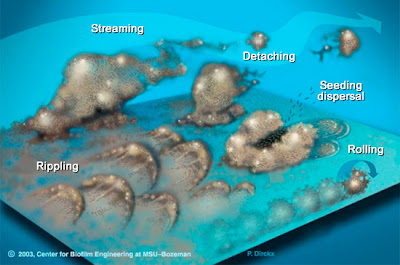According to Momba et al., (2002) several
factors promote bacterial growth in drinking water distributions systems,
called regrowth, which occurs in the water phase and in biofilms on the pipe
surfaces and reservoirs. Different factors that affect regrowth in drinking
water distribution systems are as follows:
1. Temperature and pH
Temperature and pH are major factors that affect the
microbial growth by modifying the electrostatic interactions between surfaces
and microorganisms, enzymatic reactions, and many other properties e.g. diffusivity,
solubility. Microorganisms do withstand some variations in the pH as their own
metabolic activities alter the pH in the vicinity by producing acids. But
bacteria do have their optimum pH. Chen et
al., (2005) in his recent study concluded that attached Pseudomonas
fluorescens accumulated at a greater extent and more cohesively in the
biofilm at neutral pH than in other acid or basic media.
2. Disinfectant Agents
During transportation bacterial regrowth is
efficiently prevented by using chemical disinfectant and by maintaining the
residual in distribution system. However, regrowth do occur when residual decay
further down in the distribution system. Biofilm matrix along with EPS enclosed
the bacteria and protects from the disinfectants by preventing the penetration
of biocides, limiting the diffusion or by reacting. Lower concentration of
disinfectant concentration was found within the biofilm than in the water.
Besides, it actuated first in the outermost layer where as bacteria were found
to be metabolically active in the inner layers. Induction of stress responses
and development of biofilm-specific biocide resistant phenotype may contribute
to biocide resistance (Huang et al., 1995). Pathogenic bacteria hosted
inside the protozoa were also found to be one of the ways to increase the
resistance against biocides (LeChevallier et al., 1988)
3. Availability of
nutrients
Drinking water distribution systems is an
oligotrophic environment with low contents of carbon, nitrogen and phosphorous.
Several reports from the drinking water distribution systems in Australia
(Chandy and Angles, 2001), France (Servais et al., 2004), Singapore (Hu et
al., 2005), Netherlands (van der Kooij, 1992) and China (Bai et al.,
2006) observed that the organic carbon content was the limiting nutrient
because an increase in this nutrient promoted bacteria regrowth while in other
studies conducted in Japan (Sathasivan and Ohgaki, 1999) and Finland (Lehtola et
al., 2002) phosphorus had been found as limiting nutrient. Thus, nutrient
availability, impact on structure, sloughing rate of biomass, EPS production
and microbial adhesion of biofilm (Veiga et al., 1997).
4. Hydrodynamic
Conditions
In drinking water distribution system, the hydrodynamic
conditions may ranges from laminar to turbulent flow, however stagnant
(no-flow) water also occurs in places where water consumption is low and in
reservoirs of buildings. The hydrodynamic condition may cause different effects
on biofilm accumulation and detachment. Increase in flow velocity initially
increases the nutrient transport rates until it reaches maximum and then
decreases with the further increase in flow velocity. Besides, the flow
velocity increases the biofilm density and detachment. It has been found from
previous research that hydrodynamic conditions and the nutrients are the two
major factors that influence biofilm growth, its structure, density and
thickness. Higher flow velocity have been found to increase cells hydrophobicity
that will favor cells aggregation and hence biofilm accumulation (Liu and Tay, 2001; Liu et al., 2003).
5. Surface Material
In drinking water distribution system, Iron-based,
cement-based materials and polymeric materials such as PVC (Polyvinyl chloride)
and PE (Polyethylene) are used in distribution network pipeline. In iron-based
pipeline materials, corrosion have been found as the major factor that
increases the soluble iron in the water, transport head loss and turbidity
(McNeill and Edwards, 2001).
There is still some controversy about the effect of
surface materials on biofilm development. Some researchers (Momba and Kaleni,
2002) demonstrated that drinking water biofilms grew less on polymeric
materials (PE, PVC, Teflon) than on iron
materials (grey iron, cast iron, galvanized steel, stainless steel, cemented
steel, asbestos-cement and cemented cast iron) however, opposite results were
found by other researchers (Cloete et al., 2003; Bachmann and Edyvean,
2005) where as in other works (Zacheus et al., 2000; Wingender and
Flemming, 2004) no significant difference was found.
Roughness, corrosion resistance, hydrophobicity and
hydrophilicity, Migrating components from surfaces and valves and
joints materials of the pipe materials used in drinking water distribution
system has been identified as an important factor affecting biofilm formation
(Pedersen, 1990). In a recent study it had been found pipe service age was an
important factor in the consumption of chlorine and this effect decreases in
the following order cast iron > steel > cement-lined cast iron =
cement-lined ductile iron > PVC = PE (Al-Jasser, 2007).
6. Protozoa Grazing
Protozoa are considered the major organisms
responsible for bacterial grazing in aquatic environments, which has been shown
to limit biofilm accumulation in drinking water systems (Berry et al.,
2006; Snelling et al., 2006). In contrast to predation, association of
several pathogenic bacteria to protozoa has been found as the latter have high
resistance to chlorine; hence promoting resistance against disinfectants and
increasing the health risk events.




